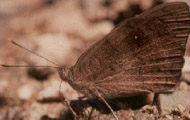Native Plants
Search for native plants by scientific name, common name or family. If you are not sure what you are looking for, try the Combination Search or our Recommended Species lists.
Bursera simaruba
Bursera simaruba (L.) Sarg.
Gumbo Limbo, Gumbo-limbo
Burseraceae (Frankincense Family)
Synonym(s): Elaphrium simaruba, Pistacia simaruba
USDA Symbol: BUSI
USDA Native Status: L48 (N), PR (N), VI (N)
The most characteristic and attractive feature of this 60 ft., deciduous tree is neither the flower nor the glossy, pinnate leaves but the smooth, lustrous coppery bark of the older stems. Crown spreading, rounded; branches large, crooked; trunk stout. On large trees, the bark often hangs in thin, papery strips. The trunk is topped by massive branches which spread out at side angles and have many stout branchlets.
The Gumbo Limbo is a member of the torchwood or bursera family (family Burseraceae) of trees and shrubs, many with smooth bark and aromatic resin. There are about 500 species in tropical regions, especially America and northeastern Africa. The Gumbo Limbo is one of only three native tree species in North America.
From the Image Gallery
No images of this plant
Plant Characteristics
Duration: PerennialHabit: Tree
Leaf Retention: Deciduous
Fruit Type: Drupe
Size Notes: Up to about 60 feet tall.
Bloom Information
Bloom Color: GreenBloom Time: Jan , Feb , Mar , Apr
Bloom Notes: Flowers inconspicuous.
Distribution
USA: FLNative Distribution: S. & c. FL
Native Habitat: Coastal hammocks & shell mounds
Growing Conditions
Light Requirement: SunSoil Description: Sandy soils.
Conditions Comments: The dense, summertime foliage creates good shade.
Butterflies and Moths of North America (BAMONA)
|
Dingy Purplewing (Eunica monima)  Larval Host |
Propagation
Description: Propagation is easy. Branches of any size take root readily when stuck in the ground. Trees grown from seed usually have a better shape, and the growth rate of seedlings is rapid.Commercially Avail: yes
Bibliography
Bibref 1186 - Field Guide to Moths of Eastern North America (2005) Covell, C.V., Jr.Bibref 1185 - Field Guide to Western Butterflies (Peterson Field Guides) (1999) Opler, P.A. and A.B. Wright
Bibref 841 - Native Alternatives to Invasive Plants (2006) Burrell, C. C.
Search More Titles in Bibliography
Web Reference
Webref 57 - Atlas of Florida Plants (2020) Institute for Systematic BotanyWebref 23 - Southwest Environmental Information Network (2009) SEINet - Arizona Chapter
Additional resources
USDA: Find Bursera simaruba in USDA PlantsFNA: Find Bursera simaruba in the Flora of North America (if available)
Google: Search Google for Bursera simaruba
Metadata
Record Modified: 2023-04-26Research By: TWC Staff